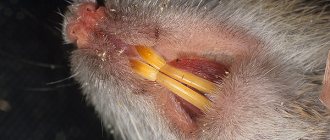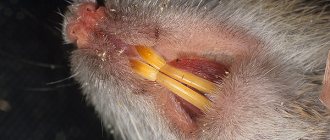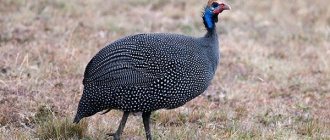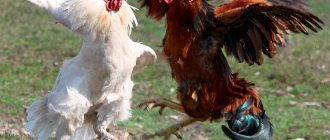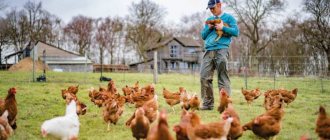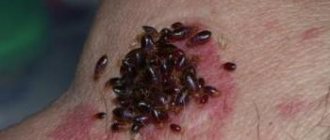1 268
no comments yet
0
Author:
Rasskazov Pavel.
Reading time: 2 minutes
A chicken, like any female, has a maternal instinct. In representatives of various breeds and crosses it is developed to a greater or lesser extent. From a physiological point of view, the awakening of the maternal instinct is caused by the action of a hormone produced by the pituitary gland. As a rule, this happens in the spring and summer.
When birds sit on eggs
To get healthy chicks that, with proper care, will turn into beautiful chickens, there are many things to consider. First of all, it is important to remember that the best time for planting is spring, since the young brood will have enough warm time to grow and get stronger for the winter. Summer and autumn are not the best periods for hatching chickens; it is recommended to artificially cool the hens' desire to hatch.
Not every individual is able to sit for the entire period. Therefore, it is also equally important to choose a suitable hen so that she can fully cope with her task. This is easy to do at home.
Chicken hatches eggs
Important! First of all, her specific behavior will indicate her readiness: she constantly clucks, lingers for a long time in the nest with laid eggs, the hen begins to pluck fluff and feathers to decorate the nest, stops laying eggs and avoids the rooster.
You can also recognize a hen by external changes. Loss of appetite and weight can be taken as a sign of readiness. Also, the hens' combs begin to decrease in size and become lighter in color.
If you cannot identify the hen by external signs, then you can try another way. First you should organize a nest by placing several decoy eggs there. A hen that is ready to brood will sit on the nest and will remain there for a long time. If her desire does not disappear within a week, then you can lay good eggs for hatching.
Nest with decoy eggs
Selection and laying of eggs
To breed healthy offspring, after choosing a hen, it is necessary to correctly select high-quality eggs that are most suitable for hatching. Eggs are selected for a number of characteristics. The material for hatching needs to be viewed against the light; it is better to do this using an ovoscope:
- the contents of the eggs should be almost transparent, not dark;
- There should be no mixing of yolk and white;
- pay attention to the absence of inclusions;
- the yolk must be fixed , that is, when turning the egg, it must also turn over at the same time, and not “float” in the white liquid.
Eggs selected for hatching must be intact, without cracks in the shell and without visible defects in shape.
Eggs selected taking into account these characteristics can be placed on the hen. It is important to observe the maximum number of eggs laid based on the size of the hen: this amount should allow the hen to cover them completely.
Why is it worth imprisoning by force?
You can wait for the natural desire to become a hen and bring offspring. But there are many difficulties here, since a hen can only start clucking in the middle or end of summer, while she has collected the required number of eggs in the nest for planting. Raising these chickens is a little more difficult.
Any representative of the chicken coop can start clucking. But if the bird is thin and weak, it may not be able to cope with the task. Experienced owners recommend choosing a hen yourself; it is best to take an experienced bird that has already coped with a similar task.
You should also thoroughly prepare the bird for its responsible mission: about a couple of weeks in advance, start actively feeding it so that it accumulates more fat and nutrients.
Important! Before forcibly placing a chicken, you should take into account that she needs a comfortable place to hatch her chicks. The nest should be located in a secluded dark place, a remote corner of the chicken coop. For example, this could be a box of straw or a basket in which the bird will not be disturbed.
Another advantage of portable planting is the ability to control the number of eggs in the clutch, as well as their quality. After all, chickens can collect eggs in their nest for a very long time, and chicks will not hatch from them. When laying the selected bird yourself, you can secretly add eggs and choose the best and freshest ones for laying.
How to plant a chicken at home
To plant a bird at home, certain points should be taken into account. It is important to choose the right individual for the role of a hen. You also need to know how to place a chicken on eggs correctly. There are several easy ways to get a chicken to sit on eggs, but first you need to organize the conditions for this.
Preparing the site
First of all, they are engaged in creating a nest. It should be placed in a quiet, calm place so that no one disturbs or frightens the expectant mother.
However, the nest should not be too large. The best dimensions are considered to be 55x35 cm. If there is a lot of free space, part of the masonry may roll out.
DIY nest
Sometimes ordinary cardboard boxes or wooden boxes filled with straw are used. In the future, the hen herself will do everything for her comfort; for this she uses her own feathers and down.
Important! In order for chickens to lay eggs at the same time, sufficient space should be provided between the nests, as conflicts may arise between them. Hens can get their clutches mixed up or even start fighting with each other. Naturally, this will not be beneficial.
How to forcefully imprison a bird
Sometimes you can resort to artificially selecting a hen and forcefully placing her on the eggs.
There are two most common ways to get a chicken to sit on eggs at home:
- You can try to speed up the development of the chicken's natural desire. To do this, place dummies of eggs in a prepared nest and observe how the chicken behaves. Gradually she will begin to go to the nest more and more often. After some time, when she begins to spend almost all her time on the clutch, you can remove the dummies and lay real eggs.
- You can also choose your own bird to play the role of hen. The decoys are placed in the nest, which is located in a remote, quiet place. The selected chicken is placed on them and the room is closed so that it cannot leave. This will help unleash the maternal instinct. As practice shows, after 1-3 days she begins to cluck and will no longer want to leave the nest. If this does not happen, the bird is replaced.
FAQ
There are some owners who want to avoid offspring, especially if the clucking occurs in August or September. Therefore, you should also know what to do to prevent the chicken from sitting down to hatch eggs at the wrong time.
What to do to prevent a chicken from sitting on the nest
There are many folk methods that will help answer the question of how to prevent a chicken from sitting on eggs. The simplest thing is to move the clucking chicken into an empty cage separately from everyone else. She is provided with food, drink and other benefits. After a few days of being unable to sit on the nest, the hen loses her instinct and returns to normal.
On a note! Since ancient times, a method of cooling body temperature has been used. During the clucking period, body temperature rises, which helps in heating the nest. If you dip the bird in a basin of cold water or pour it over it from a bucket, you will be able to bring the temperature down to the desired level.
Shock therapy to prevent chickens from sitting on eggs
This method exists, but it is dangerous to use; you can kill the bird if the procedure is carried out incorrectly. It is used in extreme cases. To carry this out you will need a transformer; you can use a charger for car batteries. There should be plates or clamps at the ends. One is attached to the comb, and the second is placed in the mouth or tied to the paw. Then a voltage of no more than 12 V is turned on for 30 seconds. The bird may lose heartbeat and breathing for some time. There is no need to explain why it is dangerous to try to wean this way, because the chicken’s life is at risk.
As it turns out, you can easily force chickens to be hatched and get a good offspring. There are many methods, developed and tested by experienced poultry farmers, that will help you get beautiful, healthy chicks by awakening the instincts of a hen and maternal feelings. Using the general recommendations proposed, it is very easy to obtain offspring that will become a worthy continuation of the birds on the farm.
5 1 vote
Article rating
What to do after a chicken lays on the clutch
To get a good brood of healthy chickens, planting a chicken is not the only task at hand. It is important to provide proper care. When a chicken sits on eggs, every owner should know what to do next. True, care procedures should begin a few days after planting. During this time, you should not disturb the bird so as not to scare it away.
When a chicken sits on eggs, don't disturb it.
Now it’s worth considering the main recommendations.
General terms
In the room where the nest with the bird will be located, there should be silence, at least relative. For successful hatching, it is necessary to ensure constant twilight, calm and silence.
Temperature
Optimal temperature conditions are also the key to a successful result. If possible, the temperature should be +10-+15 degrees with an air humidity of 75%. If you cannot create such conditions, then you should try to get closer to them.
Walks
The hen should pay maximum attention to the nest, but this does not mean that she should spend her time sitting in it. The hen should leave the nest at least twice a day to eat, drink and walk. If the bird refuses to leave the nest on its own, it should be forcibly taken outside and allowed to breathe air.
Chickens definitely need walks.
To keep the eggs in the nest warm, they are covered with a cloth. The bird should walk in the fresh air for about 15-20 minutes. If the hen does not go to the nest on her own, then she should be forced back.
Periodic cleaning
While the bird is doing its business, for example, eating or walking, you should help it put things in order. There is no need to change anything radically, just remove the dirt and waste products of the hen.
Important! You should also inspect the masonry. If there are broken or crushed eggs, they are simply removed.
Nutrition
Throughout the entire brooding period, adequate nutrition should be provided. It is best that the food is not placed too far from the nest. In this case, the hen will not worry about her clutch.
Nutrition must be complete so that the body receives all the necessary substances. It should contain special feed, crushed vitamin grass and chopped root vegetables. Naturally, water should be located not far from the masonry.
Chickens need proper nutrition
Baths
Birds, like humans, love hygiene. Therefore, it is important to provide all conditions for such procedures. It is best to place a box of ash near the nest. The bird simply loves to bathe in ash. In this way, she cleans her feathers of dirt and parasites. The bird should undergo similar procedures twice a week.
General recommendations
Chicks should hatch in 21 days. It is very good if there is an ovoscope that will help monitor the condition of the embryos. In the process, you can see pathologies and simply remove defective ones from the masonry. If a chicken sits on eggs, what to do next is clear. This will help create a comfortable environment for the chicken.
Chicks should hatch in 21 days
Nest preparation
The nest for hatching eggs can be made of wood, in the form of boxes; the frame is sometimes made of wire or woven from willow in the form of a basket. The nest must be arranged so that the hen feels comfortable in it. It should be in a quiet, warm and dry place, in privacy. It is advisable to build a nest at a height from the floor. There should be no high sides at the nest so that the hen’s access to it is not difficult. The size of the nest should not be too small for the hen, but not too wide so that the eggs cannot roll around it. The floor of the nest is covered with sawdust, hay, and down for softness. A kind of bowl is formed from hay for the hen.
At the moment when the hen leaves the nest for a while for food or other needs, it is required to clean it. The litter in the nest must be cleaned of dirt and replaced with fresh litter as necessary to prevent the occurrence of diseases in the chicken.
Why drive away the hen?
When hens begin to prepare to breed offspring, the owners have to decide what to do with the hen. There are two options. It is customary for calm birds to leave eggs.
However, 9 out of 10 modern breeders opt for incubators, driving birds away from their homes.
There are several reasons for weaning chickens from incubation:
- While raising chickens, the hen stops laying eggs, devoting a long period to maternal duties. The chick may follow its mother for several weeks, reducing farm productivity.
- The hatch is capable of hatching fifteen chickens, the incubator is capable of hatching about a hundred chickens every month. The second option is more profitable for farmers who have passed state registration - they are interested in mass breeding of chicks.
- Additional costs are another reason for weaning chickens off brooding. The hen is transplanted into a separate room to protect the chicks from attack by adult birds.
- While hatching chicks, a laying hen can accidentally crush an egg, reducing the number of young animals.
- Birds are not always able to sit for the entire period, this leads to losses.
Due to the disadvantages of natural breeding of chicks, breeders are considering methods of weaning chickens from incubation.
Jigging
Removing hens from the chicken coop is the most humane way to wean a hen from hatching eggs.
Removing hens from the chicken coop
The effectiveness of this method is achieved by following a specific scheme.
- A clucking chicken is placed in a cage measuring 70x70x70 cm
- During daylight hours, the cage is placed in the yard. An alternative to a yard is a bright, free space.
- The hen's daylight hours are increased by several hours.
- At night, the chicken is left with its relatives, but is not released, they simply place the cage in the chicken coop. The deposition lasts three days.
- Three days later, a rooster is placed with the hen.
- At night, the rooster and hen are moved to a common room.
Compliance with the presented scheme helps to return the chicken to normal mode.
Attention: the bird will lay eggs upon returning to the coop if the amount of daily feed is increased.
Traditional methods
Previously, farm production was predominantly extensive, and folk methods helped to wean chickens from sitting on eggs:
- spraying with cold water;
- darkness;
- hunger;
- plate with water.
The effectiveness of the methods has been proven by many years of experience.
Cold water
When the whooping whale shows aggression, clucks, and sits on the eggs, breeders spray the chicken with cold water or, alternatively, dip it in a basin.
You need to keep the chicken in the water for about five minutes. This is exactly how long it will take for the hen’s body to cool down. A decrease in body temperature, and not stress, as is commonly believed, discourages the bird from sitting on eggs.
This procedure should be repeated every time the bird sits on the eggs. This will allow the body to develop the ability to cool the hen's body every time she sits in the nest.
Attention: you should pour cold water over the bird only in warm weather, otherwise the chicken can easily catch a cold.
Darkness
Placing the hen in a dark, cool place solves the problem of brooding. The bird is placed in a darkened room, barn, closet, basement.
Breeders with small farms place the laying hen under a box, box, or basket, placing a weight on top. The bird is kept in the dark for two to three days.
Important! The chicken is fed in a large room. If she sits under the box, then you don’t have to feed the bird until she returns to the chicken coop.
Starvation diet
Another effective way to interrupt the brooding process is a starvation diet . The birds are kept in a separate room for three days and are not given food. When the hen stops clucking, she is transferred to a common chicken coop.
Important! When choosing a starvation diet as a punishment, you need to take into account: a hunger strike depletes the bird’s body, which means that the chicken’s egg production will decrease for a short time. But with a return to normal feeding, the size of the egg laying will increase.
Plate with water
If the owner does not have time to notice signs of readiness for breeding, a plate of cold water will help. When the chicken sits in the nest, it is driven away, and instead of the eggs it warms, a plate of water is placed.
Hatching duration
The standard incubation period is 21 days. But it can shift: exactly how many days the process of hatching eggs by a hen will continue may depend on the breed of chickens, as well as on weather conditions. In warm weather, the period may be slightly shorter, and in cold weather, a little longer, but these deviations should not exceed two days.
Chick development by day. Signs of correct and incorrect development of the embryo
Read
How to choose the right eggs to put in the incubator?
Answer
Brooders for chickens in different price segments. For hobbyists, farmers and industry
Top – 9
Review of industrial and amateur incubators for breeding chickens
Top – 15
Shock therapy
When planting and folk remedies do not help, a professional farmer uses shock therapy. Stress allows you to wean the hen from staying in the nest for a long time and sitting on eggs.
Cell
The cage, along with the hatching method, helps to wean the chicken from brooding. Poultry breeding experts recommend choosing a quail cage with a mesh bottom. The tray must be removed, leaving only the feeder and drinker.
For a week, the cage is suspended in the chicken coop, allowing the chicken to see its neighbors. The inability to communicate with other birds will be a serious stress for the individual and will prevent it from sitting on eggs for a long time.
After seven days the bird is released. If the hen sits on the eggs again, the procedure with the cage is repeated.
Attention: you can increase the egg production of a chicken by increasing the daily feed amount, as when laying.
Electricity
The most cruel but effective method is to apply electric shock to the hen. To carry out the procedure, you will need a step-down transformer and two clamps.
For greater efficiency, the clamps are distributed so that the chicken is pierced throughout the body. For this purpose, the first clothespin is attached to the bird's comb, and the second - to the leg.
When the clamps are secured, a charge with a voltage of twelve volts is applied. The procedure lasts thirty seconds.
After shock treatment, the bird is released. Thirty minutes later, the electric shock is repeated.
The brain receives a message about the danger that arises when incubating eggs, due to which the self-preservation instinct is triggered, and the bird refuses to breed offspring for a long time.
Important! The procedure may result in the death of the bird. Therefore, the use of this method is permissible only if all others are ineffective.
Reasons for awakening the maternal instinct
Laying hen on eggs
In order to combat the problem, it is worth looking at its root. A chicken, like any female animal, has maternal needs. Once a year, usually in the spring, she has a desire to breed.
Every owner can notice changes in the life of a laying hen. The first sign is an increase in egg production. The bird produces more eggs than is typical for it.
If the animal is in free movement, and does not live in a cage, then you will notice that it often disappears from sight. The chicken prepares a nest for itself, where it lays the bulk of its eggs. She can go away for a long time and sit on her eggs. The owners sometimes don’t even notice this.
If the bird is kept in a cage, then it is easiest to look at changes in its behavior. The hen becomes more aggressive, passive, and clucks a lot. May refuse food and food, wanting by any means to create a warm and secluded place for breeding.
